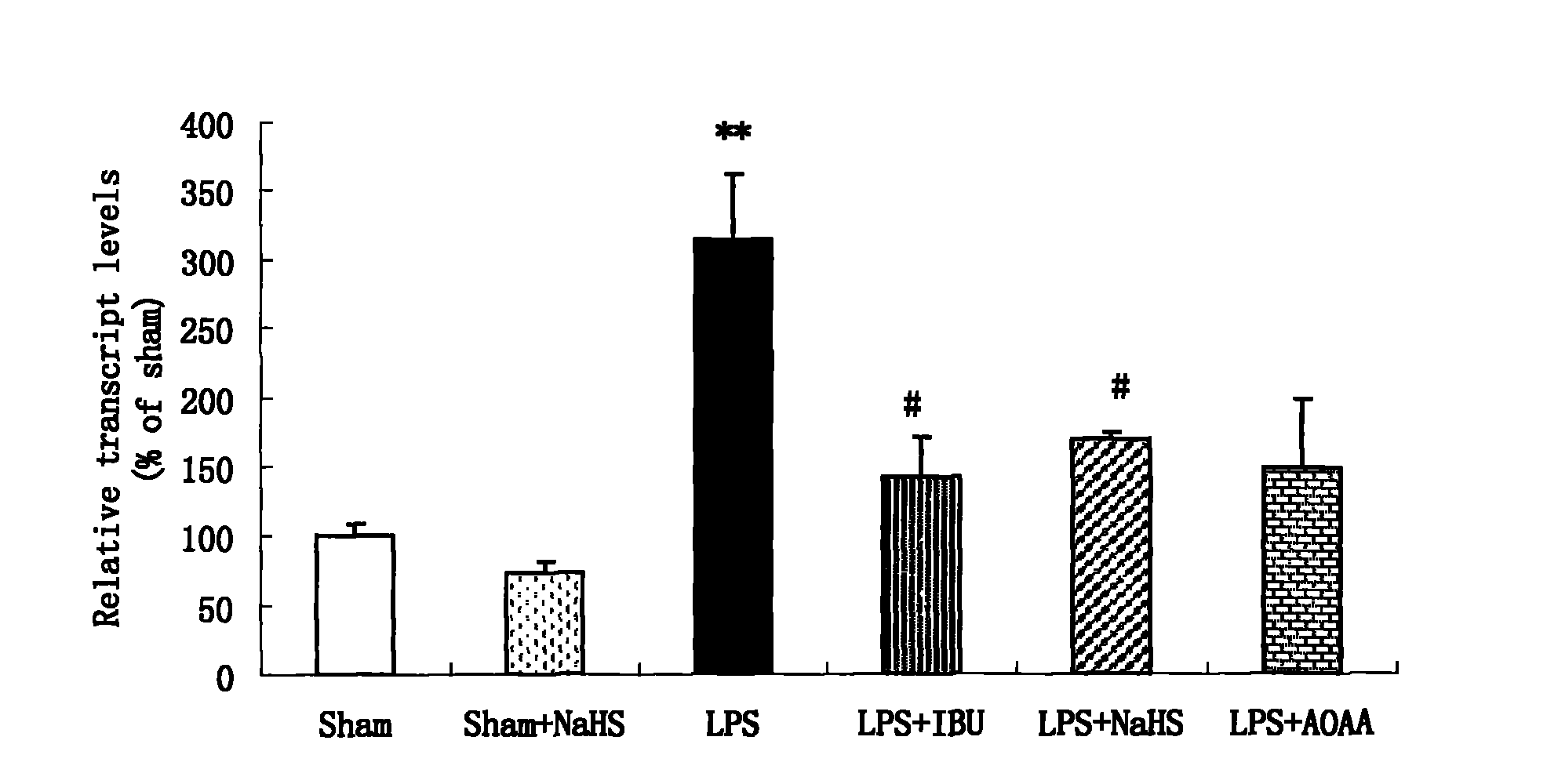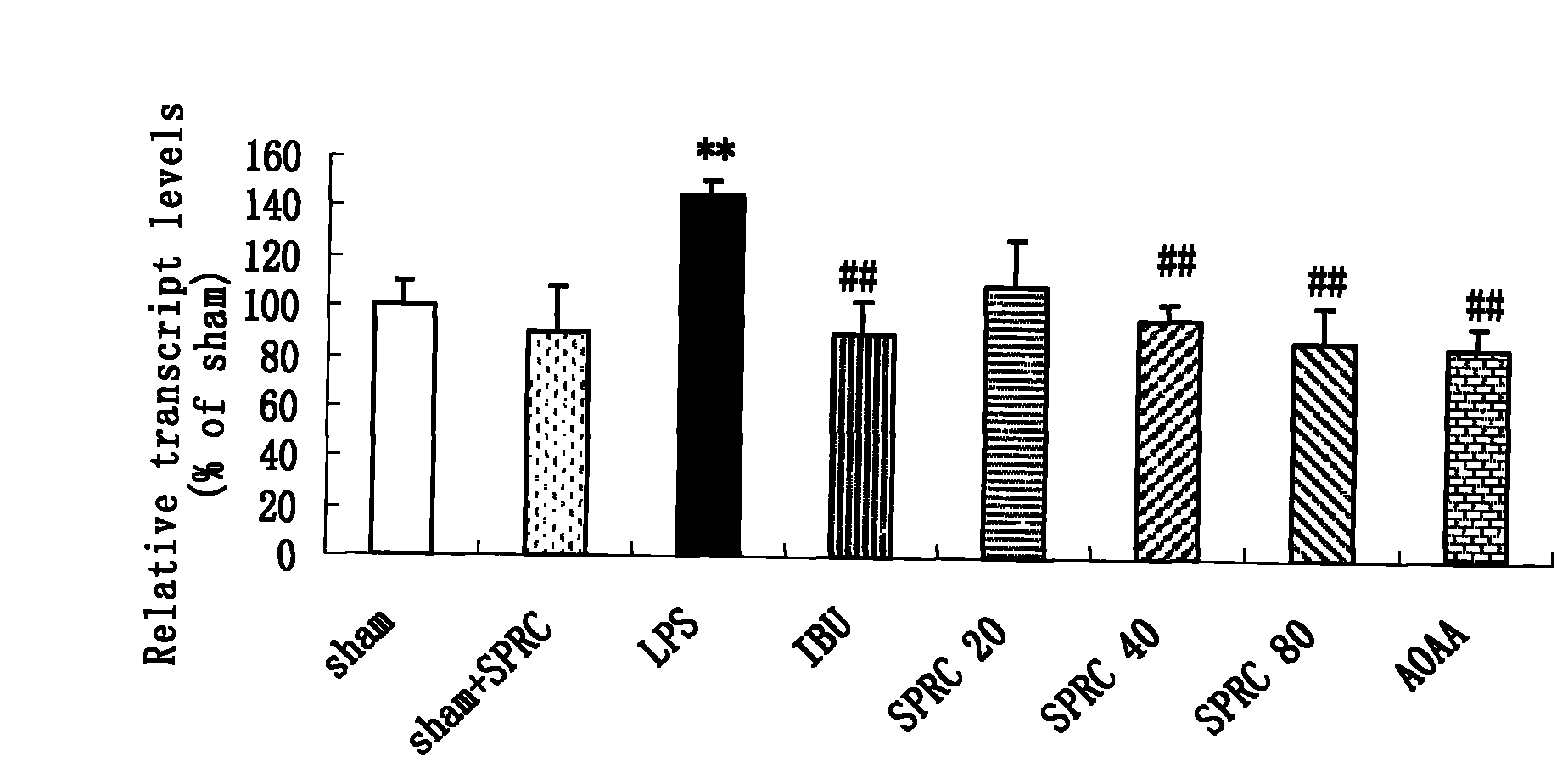Application of hydrogen sulfide donor to preparation of medicine for treating central nervous system disease
A hydrogen sulfide donor and central nervous system technology is used in the preparation of medicines for the treatment of central nervous system diseases, and the hydrogen sulfide donor is used in the preparation of medicines for the treatment of central nervous system diseases.
- Summary
- Abstract
- Description
- Claims
- Application Information
AI Technical Summary
Problems solved by technology
Method used
Image
Examples
Embodiment 1
[0034] Example 1 NaHS alleviates learning and memory impairment in rats
[0035] Sixty-eight ♂SD rats weighing 250-350g were randomly divided into 6 groups, namely Sham group (n=10), sham+NaHS group (n=10), LPS group (n=12), LPS+IBU group ( n=12), LPS+NaHS group (n=12), LPS+AOAA group (n=12). Administration began after grouping. The sham+NaHS group and LPS+NaHS group were intraperitoneally injected NaHS 5 mg / kg daily, the LPS+IBU group was intragastrically administered ibuprofen (IBU) 40 mg / kg daily, and the LPS+AOAA group was intraperitoneally injected daily Aminoacetic acid (beta cystathionine synthase inhibitor) 10mg / kg, Sham group and LPS group were intraperitoneally injected with equal volume of normal saline for 12 consecutive days.
[0036] Model making after administration 3 days, step: rat is anesthetized through 7% chloral hydrate 0.5ml / 100g, cut off head hair, disinfect, incise head skin and expose skull, bilateral drilling (coordinates: behind bregma 0.8mm, 1.4mm...
Embodiment 2
[0044] Embodiment 2NaHS increases the hydrogen sulfide content of rat hippocampus
[0045] After the water maze test, the rats were anesthetized and killed, and the hippocampus was separated on an ice tray, and one side was used for the determination of hydrogen sulfide content. The results are shown in Table 2, the hydrogen sulfide content in the hippocampus of the rats in the model group was significantly lower than that of the sham operation group (P<0.01), and the hydrogen sulfide content in the hippocampus of the positive drug ibuprofen group and the test drug NaHS group was higher than that of the model group ( P<0.05), while the content of hydrogen sulfide decreased after administration of endogenous hydrogen sulfide production blocker aminooxyacetic acid. This indicates that NaHS increases the hydrogen sulfide content in rat hippocampus.
[0046] Table 2 is the effect of NaHS on the hydrogen sulfide content of rat hippocampus
[0047] Table 2
[0048]
Embodiment 3
[0049] Example 3 NaHS inhibits rat hippocampal tumor necrosis factor-α mRNA expression
[0050] After the water maze test, the rats were anesthetized and killed, and the hippocampus was isolated on an ice tray. One side of the hippocampus was randomly selected from 4 rats in each group, and the expression of tumor necrosis factor-α mRNA was measured by real time PCR. The results were determined by the target gene / The internal reference gene (GAPDH) is indicated, and the sham operation group is indicated as 100. The result is as figure 1 As shown, it was found that the expression of tumor necrosis factor-α mRNA in the hippocampus of rats in the model group was significantly higher than that of the sham operation group (P<0.01), which was 3 times that of the sham operation group. The expression of TNF-αmRNA in the hippocampus of the positive drug ibuprofen group and the test drug NaHS group was significantly lower than that of the model group (P<0.05). This indicated that NaH...
PUM
 Login to View More
Login to View More Abstract
Description
Claims
Application Information
 Login to View More
Login to View More - R&D
- Intellectual Property
- Life Sciences
- Materials
- Tech Scout
- Unparalleled Data Quality
- Higher Quality Content
- 60% Fewer Hallucinations
Browse by: Latest US Patents, China's latest patents, Technical Efficacy Thesaurus, Application Domain, Technology Topic, Popular Technical Reports.
© 2025 PatSnap. All rights reserved.Legal|Privacy policy|Modern Slavery Act Transparency Statement|Sitemap|About US| Contact US: help@patsnap.com



